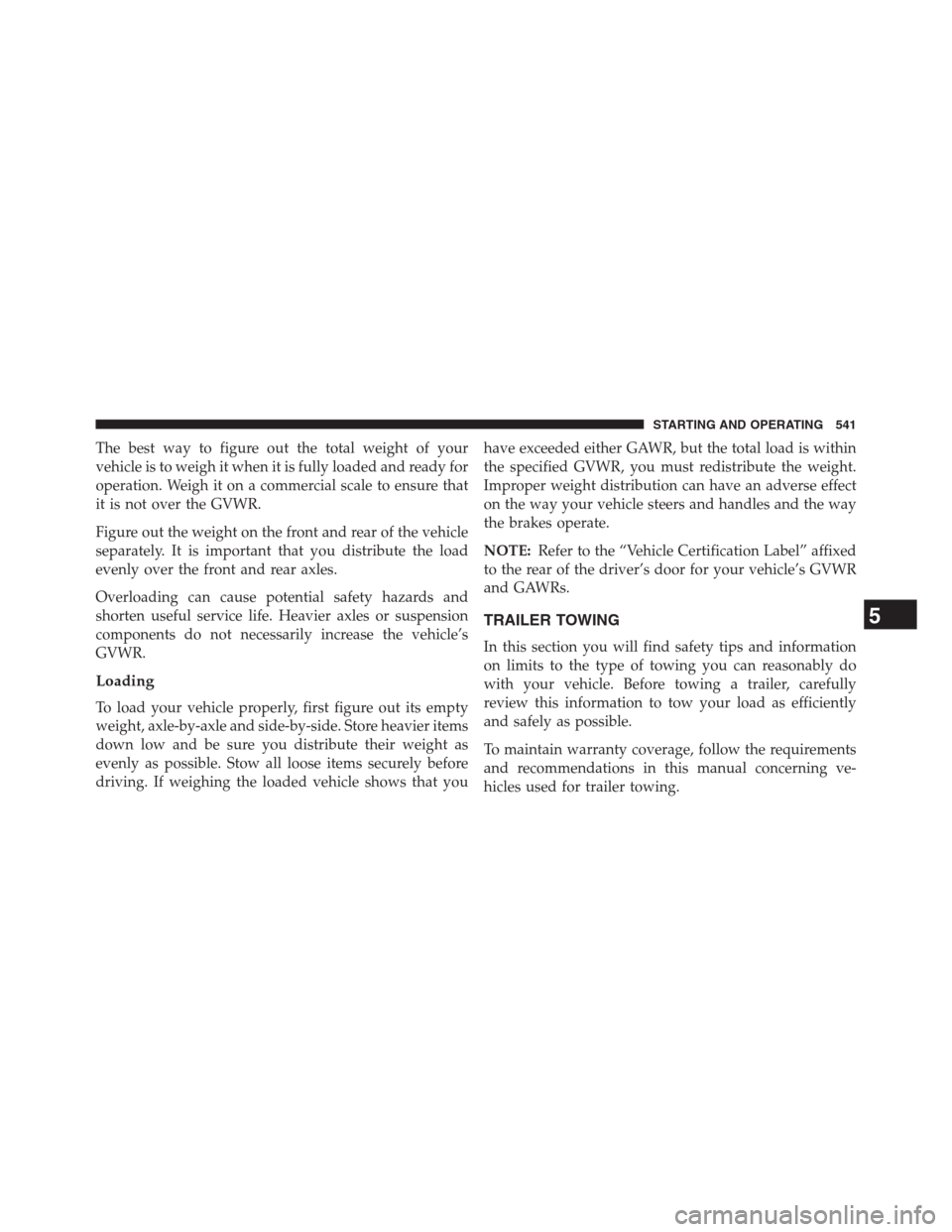Page 543 of 683

The best way to figure out the total weight of your
vehicle is to weigh it when it is fully loaded and ready for
operation. Weigh it on a commercial scale to ensure that
it is not over the GVWR.
Figure out the weight on the front and rear of the vehicle
separately. It is important that you distribute the load
evenly over the front and rear axles.
Overloading can cause potential safety hazards and
shorten useful service life. Heavier axles or suspension
components do not necessarily increase the vehicle’s
GVWR.
Loading
To load your vehicle properly, first figure out its empty
weight, axle-by-axle and side-by-side. Store heavier items
down low and be sure you distribute their weight as
evenly as possible. Stow all loose items securely before
driving. If weighing the loaded vehicle shows that youhave exceeded either GAWR, but the total load is within
the specified GVWR, you must redistribute the weight.
Improper weight distribution can have an adverse effect
on the way your vehicle steers and handles and the way
the brakes operate.
NOTE:Refer to the “Vehicle Certification Label” affixed
to the rear of the driver’s door for your vehicle’s GVWR
and GAWRs.
TRAILER TOWING
In this section you will find safety tips and information
on limits to the type of towing you can reasonably do
with your vehicle. Before towing a trailer, carefully
review this information to tow your load as efficiently
and safely as possible.
To maintain warranty coverage, follow the requirements
and recommendations in this manual concerning ve-
hicles used for trailer towing.
5
STARTING AND OPERATING 541
Page 629 of 683
CAUTION!
•When installing the Totally Integrated Power Mod-
ule cover, it is important to ensure the cover is
properly positioned and fully latched. Failure to do
so may allow water to get into the Integrated Power
Module, and possibly result in a electrical system
failure.
•When replacing a blown fuse, it is important to use
only a fuse having the correct amperage rating. The
use of a fuse with a rating other than indicated may
result in a dangerous electrical system overload. If
a properly rated fuse continues to blow, it indicates
a problem in the circuit that must be corrected.The numbers inside the TIPM cover correspond to the
following table.
Cav-
ityCar-
tridge
FuseMini-
FuseDescription
J1 40 Amp
Green— Power Folding Seat
J2 30 Amp
Pink—
Power Liftgate Module
J3 30 Amp
Pink— Rear Door Module
J4 25 Amp
Natural— Driver Door Node
J5 25 Amp
Natural— Passenger Door Node
J6 40 Amp
Green— Antilock Brakes
Pump/Stability
Control System
7
MAINTAINING YOUR VEHICLE 627
Page 630 of 683
Cav-
ityCar-
tridge
FuseMini-
FuseDescription
J7 30 Amp
Pink— Antilock Brakes
Valve/Stability
Control System
J8 40 Amp
Green— Power Memory
Seat – If Equipped
J9 40 Amp
Green— Partial Zero Emissions
Vehicle Motor/Flex
Fuel – If Equipped
J10 30 Amp
Pink— Headlamp Wash/
Manifold Tuning
Valve – If Equipped
J11 30 Amp
Pink— Power Sliding Door
Module/Anti–Theft
Module – If EquippedCav-
ityCar-
tridge
FuseMini-
FuseDescription
J12 30 Amp
PinkHVAC Rear Blower,
Radiator Fan Motor
J13 60 Amp
Yellow— Ignition Off Draw
(IOD) – Main
J14 40 Amp
Green—
Rear Window Defogger
J15 40 Amp
Green— Front Blower
J17 40 Amp
Green— Starter Solenoid
J18 20 Amp
Blue— Powertrain Control
Module Trans Range
J19 60 Amp
Yellow— Radiator Fan
628 MAINTAINING YOUR VEHICLE